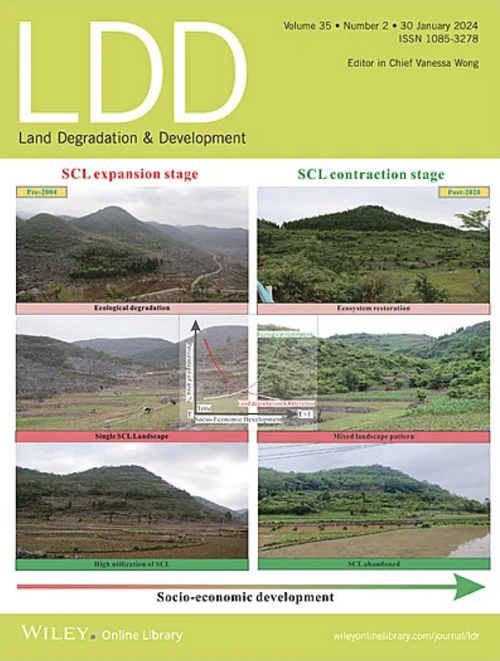Spatial Differentiation and Drivers of Functional Transition of Cultivated Ecosystems in China
IF 3.6
2区 农林科学
Q2 ENVIRONMENTAL SCIENCES
引用次数: 0
Abstract
Impairment of cultivated ecosystem functions (CEFs) is a form of land degradation. However, the mechanisms driving the functional transition of cultivated ecosystems (FTCE) and the interaction between regional differential behavior and FTCE remain unclear. To address this gap, we aimed to develop a theoretical framework and comprehensive analytical method, which combines single-factor simulation and multi-factor regression, based on the theory of agricultural-induced production substitution from the perspective of cultivated land use (CLU). The framework takes into account socioeconomic and regional elements, representing an advancement over extant studies that focus on natural ecological factors. The findings show that the high value of CEFs in China moves from the southwest and northeast to the central and Yangtze River Delta regions from 1990 to 2021. The FTCE occurs at both national and provincial scales with a U-shaped trend from rapid consumption to recovery growth. Further, there are two typical FTCE paths in China at different socioeconomic levels. At the regional scale, the FTCE in the east is mainly due to the decline in nitrogen fertilizer use intensity (NFUI), and in the central and western regions mainly due to the decline in biological disaster intensity (BDI). The mechanism driving FTCE is identified as the alternative choices made by farmers for agricultural production under different CLU goals, which are jointly influenced by cultivated land fragmentation (CLF), cultivated land scale management (CLM), and biological disaster adaptive capacity (BDC). Finally, recommendations to encourage the differentiated FTCE model in all regions of China are made with the aim of mitigating land degradation problems.中国耕地生态系统功能转换的空间分异与驱动因素
耕地生态系统功能损害是土地退化的一种表现形式。然而,驱动耕地生态系统功能转变的机制以及区域差异行为与耕地生态系统功能转变之间的相互作用尚不清楚。基于耕地利用视角下的农业诱导生产替代理论,构建了单因素模拟与多因素回归相结合的理论框架和综合分析方法。该框架考虑了社会经济和区域因素,代表了现有研究的进步,重点是自然生态因素。结果表明:1990 - 2021年,中国CEFs高值区由西南和东北向中部和长三角地区转移;在全国和省级范围内,消费消费总量均呈现从快速消费到恢复性增长的u型增长趋势。此外,在不同的社会经济水平上,中国存在两种典型的贸易创新路径。在区域尺度上,东部地区主要是氮肥利用强度(NFUI)下降所致,中西部地区主要是生物灾害强度(BDI)下降所致。农户农业生产行为的驱动机制是在耕地破碎化(CLF)、耕地规模管理(CLM)和生物灾害适应能力(BDC)的共同影响下,农户在不同CLU目标下的农业生产替代选择。最后,针对缓解土地退化问题,提出了鼓励在中国各地区采用差别化森林生态环境模式的建议。
本文章由计算机程序翻译,如有差异,请以英文原文为准。
求助全文
约1分钟内获得全文
求助全文
来源期刊

Land Degradation & Development
农林科学-环境科学
CiteScore
7.70
自引率
8.50%
发文量
379
审稿时长
5.5 months
期刊介绍:
Land Degradation & Development is an international journal which seeks to promote rational study of the recognition, monitoring, control and rehabilitation of degradation in terrestrial environments. The journal focuses on:
- what land degradation is;
- what causes land degradation;
- the impacts of land degradation
- the scale of land degradation;
- the history, current status or future trends of land degradation;
- avoidance, mitigation and control of land degradation;
- remedial actions to rehabilitate or restore degraded land;
- sustainable land management.
 求助内容:
求助内容: 应助结果提醒方式:
应助结果提醒方式:


